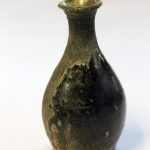“The foot (kodai) is the heart of a chawan (tea bowl),” pontificates an expert in a pottery book. We suspect that the author is as oblivious to the anatomical incongruity of his metaphor as he is ignorant of pottery basics. This supposed insight stumbles, of course, over its own feet. A chawan functions perfectly well without a foot. The foot is, to be sure, a point of reference in appreciating a chawan from an aesthetic perspective, but it is hardly the most important point of reference.
What makes a chawan a tea bowl in terms of functionality is the interior of the vessel, and an inferior interior makes for an inferior chawan. What is at issue here is neither the ease of whisking the tea nor the breadth of the bowl nor the texture of the interior surface. At issue here is appearance. And here do we encounter a fundamental difference between chawan and humans.
Individuals who present an unimpressive appearance can be, nonetheless, of decidedly impressive character. And vice versa. Yet a chawan that lacks a quality interior is of irredeemably inferior character. An interior of superlative quality can induce us, meanwhile, to overlook a chawan‘s shortcomings in regard to foot, heft (in the hand), touch (to the lips), balance, profile, and thermal conductivity. It trumps even firing effects, an undeniably important factor in chawan aesthetics.
The foregoing claim of preeminence for the bowl interior in chawan aesthetics begs the question: What of other vessels? What, especially, of tokkuri (saké flasks), whose interiors are usually concealed by darkness? This seeming conundrum yields easily, however, to observation. Any tokkuri presents an interior of compelling functionality and aesthetic completion when tilted to discharge its payload of saké. The saké traces the visible, contoured aspect of that interior as it emerges from the dark recesses and flows over the lip of the tokkuri.
Open vessels fitted with lips or spouts present a more-daunting challenge in regard to identifying the “interior” for purposes of aesthetic appreciation. Things get especially confusing with vessels configured as chawan in every respect except that they have a lip (or even a spout). The presence of a lip, however, is definitive. In seeking the interior, we need to focus on the lip. Our eye moves from where the wall of the vessel bends outward and follows the protuberance to the end of the lip.
Thus do vessels of any configuration reveal, under careful observation, interiors worthy of aesthetic appraisal. The trained eye soon discovers interior aspects even in pottery other than functional vessels. And the precedence of “interior” among our criteria for evaluating aesthetic attainment and character pertains to realms beyond pottery. We can deepen our appreciation of architecture, for example, by identifying and appraising elements that correspond to the chawan interior. The bold among might dare even to employ the same approach in evaluating human character.






